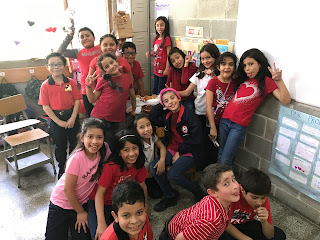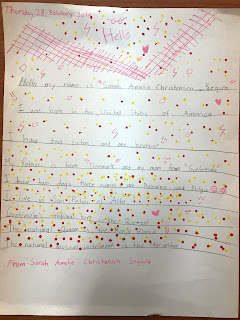Sweet Students and Fun Projects
As we go into April, the first quarter has finished, and we're about two weeks into the second. The past two and a half months have been non-stop busy with lessons to plan each week, quizzes to make, workbooks to check, activities to grade, and more. Nevertheless, I've been learning a lot, improving my skills, and enjoying the company and pleasure of teaching a great batch of kids.
I'm teaching Third Grade, which is the biggest group in Primary with 18 students in my homeroom section and 20 in the other. I enjoy teaching this grade. These particular group of students have a good level of English, and I can hold conversations with them in English. Aside from that, they're at an age where they can understand my classes in English, they can work (fairly) independently, but still love to play games and receive hugs. I have some extra love for my homeroom section who have been very sweet to me, welcoming me as a new teacher, and always leaving me messages on the whiteboard. They've been some of my best helpers when trying to navigate the ins and outs of the school; I sometimes feign ignorance when an event is coming up, and they're more than happy to help me out and tell me what I have to do, and all in English!
They've also been helping me out with ideas in the classroom. During our second week, they begged me to play "Simon Says." I didn't think of it at first, because I thought they were too old for it and wouldn't enjoy it, but they love it. We use it to practice vocabulary and I have 100% participation when we play. I recently taught them how to play "Paint me a picture," and it's become another class favorite to add in the rotation. The past week, we started learning vocabulary on places in the community. It was my kids who came up with the idea to make a model of a community. I agreed, but switched it up a bit and instead of letting the kids pick their groups as is what usually happens when we do group work, I assigned them groups. Since the project itself was fairly easy, it was a good time for them to practice cooperation and social skills, working with others who aren't their best friends.
It became a week-long project, as they worked on it for about 20 minutes each day, and at the end they had to give an oral presentation. It was very successful -- with just two groups having fights/problems -- and they did well in their oral presentation, being really invested in the project.
They've also been helping me out with ideas in the classroom. During our second week, they begged me to play "Simon Says." I didn't think of it at first, because I thought they were too old for it and wouldn't enjoy it, but they love it. We use it to practice vocabulary and I have 100% participation when we play. I recently taught them how to play "Paint me a picture," and it's become another class favorite to add in the rotation. The past week, we started learning vocabulary on places in the community. It was my kids who came up with the idea to make a model of a community. I agreed, but switched it up a bit and instead of letting the kids pick their groups as is what usually happens when we do group work, I assigned them groups. Since the project itself was fairly easy, it was a good time for them to practice cooperation and social skills, working with others who aren't their best friends.
It became a week-long project, as they worked on it for about 20 minutes each day, and at the end they had to give an oral presentation. It was very successful -- with just two groups having fights/problems -- and they did well in their oral presentation, being really invested in the project.
Teaching at this school is unlike my other experiences. While the schools I worked with in Spain were bilingual schools, being an assistant and not the main teacher led me to have a very different role. At this school, I'm the teacher in charge for English of Third Grade, and it's my first time to have a book and a curriculum to guide me. The book can be challenging at times -- I feel like it's written for learners of English as a first language rather than second -- but I've learned to work with it. That aside, I've been enjoying teaching at a high level bilingual school. Like I mentioned, my students have a pretty good level of English and which I feel has allowed me to become more creative with the activities we do. In our book, one of our units was about new experiences and moving abroad as well as learning "why" and "because" for grammar points, so I decided to work on a project with my kids where they had to pick a country they wanted to move to. After, they did a little research on that country, then eventually wrote about why they wanted to move there. A lot of kids picked Mexico, a few picked Spain, another handful picked countries like Canada, Chile, China, Denmark, and one of my sweet kids picked the Philippines. He did his research writing 5 facts about the Philippines, and his classwork on 5 reasons why he wants to move to the Philippines was the cutest.
Another project that I was really excited to try was a letter exchange or pen pal. I messaged a teacher from the school I studied and worked at in the Philippines if she would be interested in our students exchanging letters. It also tied up really well with our book's lessons as they were learning about other cultures, moving abroad, experiences, and letter writing.
My kids started off the first exchange. They wrote a letter "to their new friend," sharing a little bit about them and about Guatemala. Because of the Philippine's slow postal system and Guatemala's non-existent one (I was not about to DHL or FedEx a bunch of letters), I just took photos of the letters the kids wrote, and sent those. A few weeks later, the students from the Philippines replied, and I printed out the pictures of the letters they sent to share with my students. They were so excited about it, reading and rereading their letters, then sharing them with their friends. In the end, they were struggling to reply -- the concept might have been a bit foreign to them, not knowing what to say back -- but they still came out with some nice letters.
The other day we had our Entrega de Notas, which are like Parent Teacher Conferences back home where parents come to get the report cards of their students and can talk to the teachers. Out of my 38 students, I had 13 parents come, mostly the ones of the better students. Still, it was nice to talk to them, and it was reaffirming to hear that their kids were happy in my class. Several parents also shared how much their students loved the letter writing activity, and one mom said that her daughter saw the value in English since she could use it to communicate with other people. After all, despite being fairly good at speaking English, the students are still in a Spanish speaking community and rarely put their English into practice outside of school. It was a touching and gratifying moment, and a lovely reminder of why I continue to love teaching.












Comments